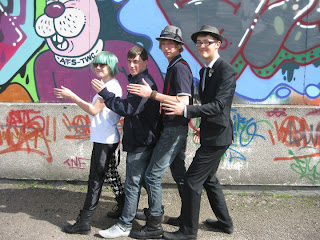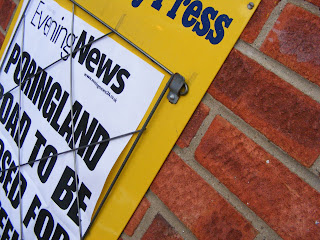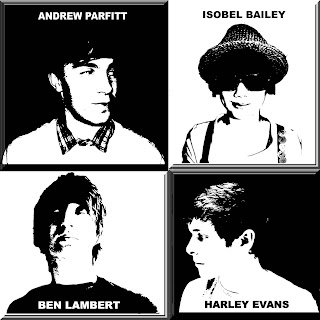One of the most vital media technologies that I used during the construction process of the music video was the digital video camera. For obvious reasons, this was a key technology throughout the entire shooting phase. As well as the capturing of the footage to be used for the final edit, we could also use the camera to experiment with different shots. We had previously learned from the preliminary task last year that different shot types have different effects on the audience, for example low angle shots of a subject make them appear powerful and menacing such as this shot below.  We were able to combine this knowledge with the technology at our disposal by experimenting with various shots to gain desired effects. We discovered that close-up shots of our main actor both established her as the lead singer as well as conforming to conventions of the genre and music style, as combined with a handheld camera and the action shots of the band ‘skanking’ (a type of dance often performed to ska music) made the shot type appear fun and quirky, much like our soundtrack. We could also use the pause, rewind and play features on the video camera in order to review our raw footage whilst out on shoots. This feature enabled us to save great deals of time when constructing the video, as the only other method of viewing the footage would have been to link it up to a computer. Because we could view the footage we had just taken when out on a shoot, this gave us the opportunity to immediately review the different shot types and evaluate their effectiveness. We could then make a group decision as to whether it was suitable, or whether it needed to be re-shot, attempted from a different position with different actors, or ignored completely when undertaking the editing process (these all being just a few examples), such as the initial shot we took of the lead singer getting ready in the mirror; upon reviewing the footage it became apparent that the camera was visible in the mirror in the background, thus we knew we had to re-shoot. Because of this, this feature of the camera enabled our progression greatly.
We were able to combine this knowledge with the technology at our disposal by experimenting with various shots to gain desired effects. We discovered that close-up shots of our main actor both established her as the lead singer as well as conforming to conventions of the genre and music style, as combined with a handheld camera and the action shots of the band ‘skanking’ (a type of dance often performed to ska music) made the shot type appear fun and quirky, much like our soundtrack. We could also use the pause, rewind and play features on the video camera in order to review our raw footage whilst out on shoots. This feature enabled us to save great deals of time when constructing the video, as the only other method of viewing the footage would have been to link it up to a computer. Because we could view the footage we had just taken when out on a shoot, this gave us the opportunity to immediately review the different shot types and evaluate their effectiveness. We could then make a group decision as to whether it was suitable, or whether it needed to be re-shot, attempted from a different position with different actors, or ignored completely when undertaking the editing process (these all being just a few examples), such as the initial shot we took of the lead singer getting ready in the mirror; upon reviewing the footage it became apparent that the camera was visible in the mirror in the background, thus we knew we had to re-shoot. Because of this, this feature of the camera enabled our progression greatly.
Having uploaded this raw footage onto the computer via a firewire cable, we were then able to open this footage on a programme called ‘Adobe Premiere Elements’. This editing software was a key element in the production of our entire video. Firstly, we were again able to review the entirety of the footage we had taken on a larger screen, in better quality, as opposed to the small screen on the camera we had used whilst on the shoot. This allowed us to make an informed decision on the quality of the shot, and could notice any small faults with the shot or quality of the picture that were not previously apparent. For example, whilst shooting some of our cast ‘skanking’ the quality of the video at the time of the shoot looked adequate, however once viewing it on Premiere Elements on the computer small areas of the footage had become clearly pixelated, so rejected it in our final edit. Having decided which footage was of good enough quality, we were then able to copy and paste different shots into a rough narrative order in correspondence to the storyboards we had each individually produced prior to the shooting of the footage. In our case, the video was a concept based montage of shots that are appropriate to the genre with a number of performance shots as opposed to a strict narrative like that of our AS thriller production, though we were still able to use the storyboards to aid our ordering of footage on PE (Premiere Elements). We could use PE to cut the lengths of the shots, which allowed us to obtain the effect of a fast-paced montage by having very short shots that were on screen for a small period of time such as the fast-paced performance shots of the band playing instruments; this was one way in which we used PE to conform our video to the fast-paced feel of the ska genre as it helped create connotations of fun and chaos. The use of cross-fades between shots featured largely in our video, as it was unanimously agreed that these helped the images flow seamlessly whilst adding dimension and making the viewing experience more pleasurable. Our longest and probably best example of this in the video is that of our band ‘skanking’ on one layer of footage, and a tracking shot of a row of terrace housing on the other layer to emphasise the British roots of the genre. Our inspiration for this was taken from a shot in This is England where terrace housing is the focus of attention, being filmed through the window of a moving car. The section of this from our final production is shown in the box below. We were also able to increase the saturation of the footage. On one of our early shots of the band walking across the wooden beam, there is a backdrop of a street wall covered in graffiti, though the initial shot was particularly dull and not as aesthetically pleasing as possible. We were able to use the saturation tool on this shot, where we could use a drag bar to adjust it positively or negatively. We used this effect to make the whole shot appear brighter and far richer in colour, as we decided this bright, bold effect to be fitting of the ska genre and our soundtrack as it is a particularly energetic sound, and the high energy of it can be visually represented by the increased richness of colour. The comparison between our original, slightly dim shot and the final one with increased saturation can be seen below.
In terms of my print productions I used a stills digital camera to take the images that I used in nearly all of my panels. Whilst out on the shoots for the footage of the video, I also used a stills camera to take higher quality images to potentially use for my print productions. I stored these on my memory stick and was then once the music video had been completed, I had a large selection of images to choose from and could decide which would be most effective to use. I wanted to use the images which were most appealing and fitted best with the two-tone and ska/punk genres, so having chosen some of the raw images shown below,



All of these new technologies offer a vast opportunity to increase creativity. For example, in times prior to the emergence of Adobe Photoshop, media students would have had much less powerful editing software at their disposal, with far less possible effects to be used. Because of this huge array of effects to experiment with, new ideas are inspired during the editing process of print productions so consequently benefit your creativity. If I as a student only had the more primitive Microsoft Paint software to edit my magazine advert, I would not have discovered the spotlight tool as I did with Photoshop, and my final design would be lacking it’s main feature of spotlighting Izzy to establish her as the lead singer of the band in such an interesting way, so would have ended up being far less creative than when these new technologies are available.
In terms of my research, technologies were again of vital importance as without the ability to use the internet search engine ‘Google’ I would not have discovered such unsigned music websites as www.unsignedbandweb.com and would have not come across our own unsigned band, The Skanx. Via this unsigned band website we were able to come across the official website of our band www.theskanxband.co.uk on which we found our track ‘moneygrabber’, so Google was entirely important to finding the aforementioned websites that led us to our chosen track; without them finding it would not have been nearly as simple, if even possible.
Youtube was a key technology used throughout the process of research. In order to maximise the quality and effectiveness of my own productions, I had to research other similar media products from which to take inspiration and ideas, so when in the research stage of producing my music video, I used Youtube to search existing videos from other artists. By far the most influential band to my own work is Madness, and using Youtube I was able to view their video for One Step Beyond numerous times, and was also able to embed the video onto Blogger. This enabled my tutor to keep an ongoing watch on the progress on my research to keep me updated as to how to improve my analysis or other aspects of research, and was also a clear and easy to access way in which to present my research for future reference when planning. Upon viewing the One Step Beyond video which is a very typical example of the two-tone sub-genre, we took inspiration from it in the form of the ‘Madness Walk’, a type of movement performed by the band in the video that we later attempted on a shoot and eventually used to good effect in our own video, as it directly linked us to Madness and hence highlighted the genre we were trying to fulfil. Because of Youtube we were able to use this video as a direct intertextual reference. As well as using Youtube to view similar bands’ music videos, we also used it heavily to research both the film and tv series of This is England, which was by far our most influential non-musical existing media product. I again embedded clips and images from the film and tv series onto my blog as we took inspiration for our costume heavily from them. Dr Martens boots, braces and Fred Perry shirts are featured heavily in the music and print productions, and because of Youtube and being able to embed clips onto our blogs we were able to reference this fact as being the inspiration from which we took our own costume ideas. Without technologies such as Youtube and Blogger our group would have not been nearly as informed about costume that is fitting of the genre, and consequently our final video would not have been nearly as effective.
I used a less conventional method of researching existing products when in the stage of researching for print productions. Before beginning the editing of my digipak, I used Apple’s music software iTunes on my own computer to scan through the different album covers of various artists in my own music library to gain inspiration for my own album cover. I already had a rough idea of what I was looking for, but the ‘coverflow’ feature on my iPod  allowed me to quickly scan through hundreds of existing album arts in order to back up my vague initial ideas. Doing this, I came across the front cover of Blur’s ‘Best of Blur’ album
allowed me to quickly scan through hundreds of existing album arts in order to back up my vague initial ideas. Doing this, I came across the front cover of Blur’s ‘Best of Blur’ album  and saw it to be an effective method of establishing the band whilst being typical of the band’s pop rock genre in it’s pop-art style and colour scheme, so embedded the image onto my blog and commented on it’s effectiveness in a previous post regarding print productions. I eventually ended up using an extremely similar idea in my own digipak (panel 2) though changing the pop-rock connotations from the Blur album to one’s fitting of the ska genre (by changing the threshold of the image on Photoshop to make the image black and white
and saw it to be an effective method of establishing the band whilst being typical of the band’s pop rock genre in it’s pop-art style and colour scheme, so embedded the image onto my blog and commented on it’s effectiveness in a previous post regarding print productions. I eventually ended up using an extremely similar idea in my own digipak (panel 2) though changing the pop-rock connotations from the Blur album to one’s fitting of the ska genre (by changing the threshold of the image on Photoshop to make the image black and white

– typical of two-tone ska), so because of iTunes I was able to discover an effective existing album art and use it as a strong reference for my own productions.




















